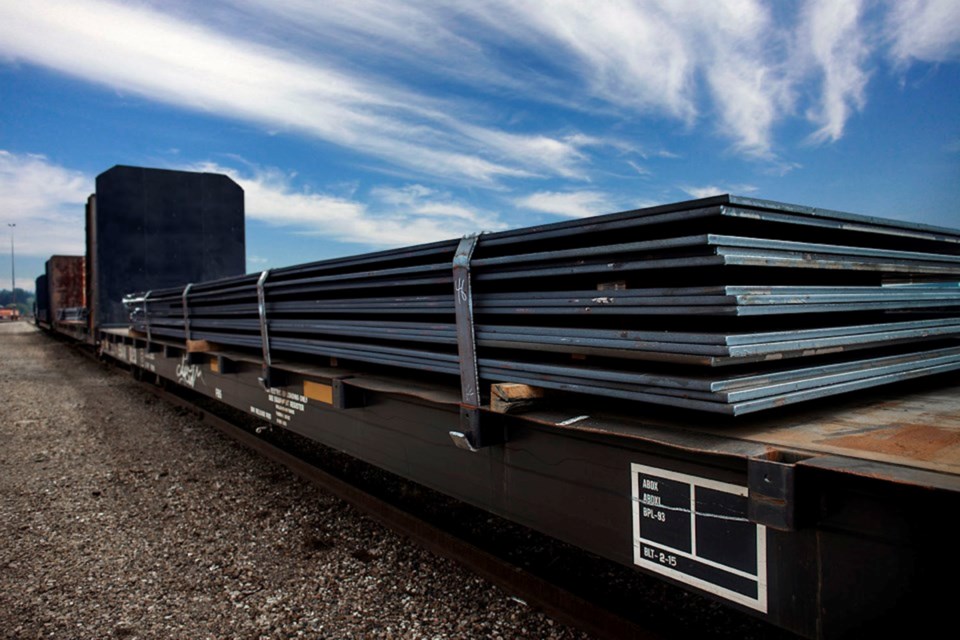Inflation and global supply chain issues have ballooned the price tag of Algoma Steel’s big ticket Electric Arc Furnace (EAF) and will delay its startup.
The Sault Ste. Marie steel company updated its process on the $703-million capital project this week in releasing its 2023 fourth-quarter and year-end performance.
Algoma Steel’s fiscal year runs from April 1 to March 31. The year ended on a tragic note with the death of a subcontractor on the site last week.
The rising costs associated with skilled labour, construction material and currency fluctuations are being blamed for an increase in the range of $125 million to $175 million from the original 2020 budget for the two-furnace complex.
On top of that, a global shortage of micro-processing chips — used in control systems — caused by supply chain issues means the start of commissioning of the first furnace will be pushed out from the middle of next year to year's end.
CEO Michael Garcia said in a June 22 webcall that the revised timeline will not impact their plans to make the switch to arc steelmaking in mid-2025.
The furnaces are a transformational technology in the history of the 122-year-old company in transitioning away from coal-fired steel production into the modern era of cleaner manufacturing by eliminating its coke ovens, blast furnace and basic oxygen furnace.
The improvement will cut greenhouse gas emissions by 70 per cent and boost Algoma’s annual steelmaking capacity from 2.8 million tons to 3.7 million tons.
In an explanation to analysts of the cost overrun, Garcia said about 80 per cent of the original budgeted costs for the furnace project were contracted out during the past fiscal year with only 20 per cent remaining uncontracted by year’s end.
The EAF project is planned and divided up into major construction packages. The initial major ones — like awarding the furnace contract to Danieli and the building construction contract to the Walter Group — were locked in on a fixed price.
But at that point, he said, it was too early in the project life to award the rest of the packages since detailed engineering needed to be done before the remaining bid packages could go out.
When detailed engineering was wrapped up six or seven weeks ago and those packages went out, that’s “when we saw a pretty different market for construction costs” than from the early, large bid packages in 2021.
“We started to see an emerging risk in those packages coming back higher than the original budget,” said Garcia.
These contracts involve equipment, electrical and piping installation, and work on the furnace complex’s fume treatment plant.
Garcia expressed confidence that cost range won’t go higher.
Financing the balance of the project won’t be a problem, the company insists. There’s cash on hand, revenue generated from steelmaking operations, and they can tap into an unused line of credit from its lender that Algoma recently negotiated to upsize and extend.
Garcia confirmed they have no intention of going to market for additional financing.
“We are pretty confident about funding the EAF,” added CFO Rajat Marwah.
North American steel markets are historically feast or famine. Algoma’s last two years have been proof of that.
Algoma posted a profit of $298.5 million for its 2023 fiscal year, which ended March 31, a steep drop from $857.7 million recorded during the 2022 fiscal year. The fourth quarter showed a loss of $20.4 million, a flip from the $242.9 million profit during the same quarter in 2022.
Still, Garcia refers to the fourth quarter as a “solid end to a very exciting year,” in rebounding off tough second and third quarters where North American steel markets softened and prices plummeted.
Steel shipments for the year were slightly more than 2 million tons, compared to almost 2.3 million tons shipped during the 2022 fiscal year.
Consolidated revenue for the year amounted to more than $2.7 million, down from $3.8 million tabbed the year before. Income from operations for the year were $290.5 million, compared to more than $1.4 billion in 2022.
Those declines are attributed to low steel prices, the cost to purchase coke — following a coke oven fire at Algoma last summer — and the cost of raw materials and natural gas. A new labour agreement last year resulted in increased pension and post-employment benefit expenses, the company said.
On the plus side, the company received conditional permission from Ontario’s Independent Electricity System Operator to plug the furnaces into the provincial grid. Algoma also finished installing and testing two natural gas-fired turbines, and all the control systems, in its on-site Lake Superior Power plant.
The furnaces will draw from these two sources of power.
Now well into its 2024 fiscal year, Algoma predicts better days are ahead.
In his forecast, Garcia said he expects to see greater stability in the market, judging by the order book from Algoma’s 160 customers, and he’s encouraged by steel price increases announced by other North American producers in recent weeks.
Upgrades to its plate mill project is ahead of schedule and the company expects to start commissioning that mill in August. As soon as October, Garcia said, the market can expect to see a 15 to 20 per cent increase in shipments.




